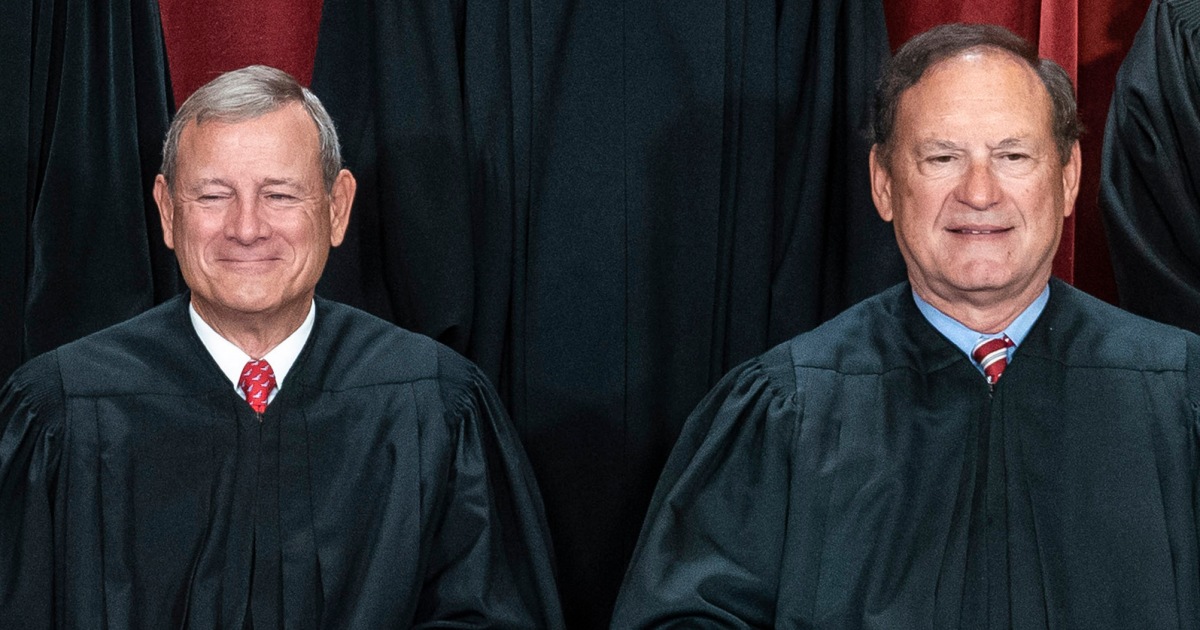One of the many big stories of this past Supreme Court term is Justice Samuel Alito’s refusal to recuse himself from Jan. 6-related cases, despite the appearance of impropriety from flags flying at his homes that Jan. 6 rioters also carried. A new report from The New York Times sheds more light on the situation, painting a potentially even more damning picture of the episode.
The Times reported Sunday that Alito was originally assigned by Chief Justice John Roberts to write the majority opinion in Fischer v. United States, the case that narrowed obstruction charges against Jan. 6 defendants. The appeal didn’t involve Donald Trump directly, but some of the Republican presidential nominee’s charges in his federal election interference case involve alleged obstruction, so he could benefit from the Fischer decision as well.
But according to the Times, Roberts took over the opinion shortly after the Times reported in May that an upside-down flag — a symbol of the Stop the Steal movement — flew outside Alito’s home following the Jan. 6 attack on the Capitol. We already knew that Roberts authored the 6-3 ruling in Fischer, published June 28, which Alito joined. But Alito initially being assigned by Roberts to write it is a new detail. When he’s in the majority, the chief has the power to assign who writes the opinion; otherwise, it’s the senior-most justice.
NBC News and MSNBC have not independently confirmed the Times report, which also explored the rulings granting Trump broad criminal immunity and keeping him on the presidential ballot despite the Constitution’s insurrectionist ban. The report said it’s based on “justices’ private memos, documentation of the proceedings and interviews with court insiders, both conservative and liberal, who spoke on the condition of anonymity because deliberations are supposed to be kept secret.”
So why did Roberts reportedly make the highly unusual move of taking the Fischer opinion from Alito? The Times reported:
Who initiated the change, and why, is not clear. The switch came days after The Times reported that an upside-down flag, a symbol of the Stop the Steal movement, had flown outside the Alito home following the Capitol attack. While that timing is suggestive, it is unclear whether the two are linked. (All nine justices declined to respond to written questions from The Times, a Supreme Court spokeswoman said.)
But if the change in authorship was motivated at all by the appearance of impropriety of Alito authoring a Jan. 6-related opinion while facing recusal calls, then that should have been a sign to Roberts and Alito that Alito had no business sitting on the case.
That is, if potential concern with making Alito the face of a pro-Jan. 6 defendant ruling was enough to take away the opinion’s authorship from him, then that same concern should have led to Alito not participating in the case, whether he was the author of the opinion or not. (The court did not immediately respond to my questions about the Times report regarding authorship and motivations behind Roberts’ reported reassignment.)
If Roberts thought that taking over the opinion would avoid appearance concerns, he actually has only made things worse.
Subscribe to the Deadline: Legal Newsletter for updates and expert analysis on the top legal stories. The newsletter will return to its regular weekly schedule when the Supreme Court’s next term kicks off in October.


Leave a Reply